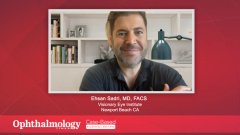
Patient case #2: 67-year-old white female with open angle glaucoma benefits from minimally invasive glaucoma surgery
Ehsan Sadri, MD FACS reviews the case of a 67-year-old white female with open angle glaucoma and how she benefits from minimally invasive glaucoma surgery.
Ehsan Sadri, MD, FACS: Our next case is a 67-year-old Caucasian female who presents with glaucoma, moderate to severe visual field loss, intraocular pressures [IOPs] that are ranging in the 20s mm Hg, presents at 21 mm Hg. Normal anatomy and clear media for visualization. Essentially the patient has been on multiple drops and complains about a lot of eye pain, redness, and aesthetic issues. The patient was sent over by the optometrist to evaluate for possible SLT [selective laser trabeculoplasty]. The patient has some questions about the microstent, which includes the Hydrus procedure. So, it is a pretty mature patient who comes in with some ideas on what they want.
The takeaway of this slide is that optic nerve hemorrhages present in different types and locations, and they’re fleeting. If the patient presents this way in your chair, if you bring them back in a month or two, this Drance hemorrhage is gone. The take-home here is that an optic hemorrhage is essentially a glaucomatous eye until proven otherwise, and more specifically, it’s a patient with normal tension glaucoma. The patient here, although the intraocular pressure was 21 mm Hg when we saw them, I would not be surprised with pressures in the 50s and 60s mm Hg and still progressing. It’s a very challenging case, normal tension glaucoma, because your pressures are seemingly OK, but the reality of the patient’s optic nerve is cupping.
When evaluating the intraocular pressure reduction post-OMNI procedure for this patient, which is what we’re presented with, if we did the trabeculotomy and goniotomy, you can see the patient went from 21 to 14 mm Hg. When we studied the literature, and we’ve done our own clinical trials on this device, you can see up to 40 points reduction of the mean intraocular pressure. But in addition, for the patients it usually means for them a loss of medications, which is kind of nice. Often the question that comes up is patients don’t appreciate necessarily the IOP reduction, although they know it’s important to you. What’s more important to them is how many medications they have to be on because they have so many issues with them. No. 1 is the cost and No. 2 are the adverse effects. We’ve shown and the literature has shown that the major advantage of angle-based surgeries, MIGS [minimally invasive glaucoma surgeries], in this case OMNI, you can see a nice reduction in intraocular pressure.
The other thing that we’re studying right now and publishing is the patients' quality of life measurement outcomes. In other words, how are patients responding to this technology from a quality of life standpoint, which we rarely look at, because it’s hard to study. But to me it is important, because for years and years, decades really, we’ve had intraocular pressure and great hypertensive drops, but the issue is compliance. The National Eye Institute shows that when a patient is on 1 agent and goes to 2 agents, there’s almost a 53% reduction in adherence and compliance. And when you go to the third agent, like this patient had, you’re looking at another 25-basis point reduction, so really a 75% loss of adherence. That’s problematic because we know it’s a progressive disease. The patients are essentially doing what I call dental flossing, or eye flossing, they’ll put the drops in a few days before they come to see you because they know you’re going to measure the pressure, and the pressure may be great in the chair. But you notice the visual field and increased cupping. It’s problematic, and something needs to be done. We’re in an era now, as you know, of early intervention, and MIGS fits in nicely with that.
Transcript Edited for Clarity
Newsletter
Don’t miss out—get Ophthalmology Times updates on the latest clinical advancements and expert interviews, straight to your inbox.
















































